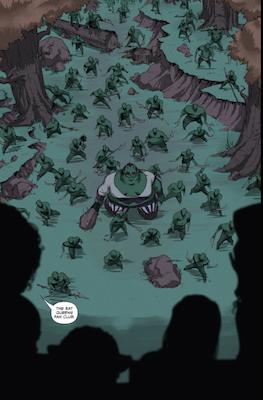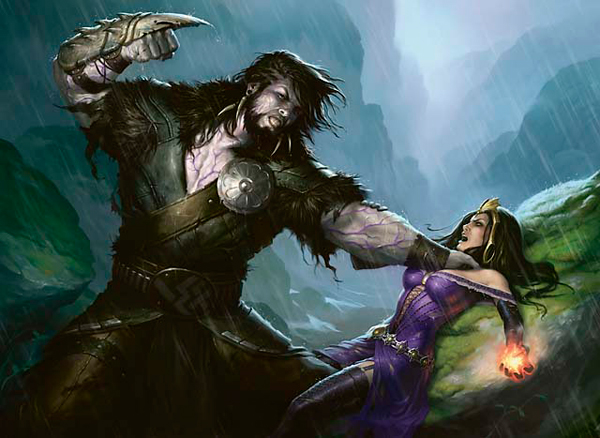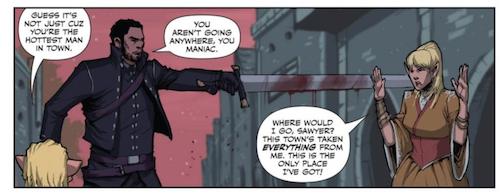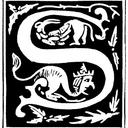Fighting female goblins isn't necessarily violence against women
Also in preparation for The Tome Show review of the 5e Monster Manual, I've been reading other people’s reviews and reactions to reviews. One strange argument I’ve read suggests that we shouldn’t have more female combatant NPCs in Dungeons & Dragons because violence against women is a thing. I’d like to address this argument because I see too many people accepting it at face value and I think that actually ends up perpetuating sexism and violence against women.
I don’t know about you, but I know many boys during my childhood were told “don’t hit a girl.” When a local girl joined the middle or high school football team, I read article after article that worried that the boys would get all confused about whether or not they could hit girls if they had to compete with one on the playing field. My own principal in middle school declared at an assembly that it would be over his dead body that any girl in his school earned a position on the football team.
Controlled violence between equals was forbidden if one of the participants was a girl and the other was a boy. However, when the boys snapped my bra or threatened to rape me when the monitors weren’t looking or dragged me around the playground because I had taken out the classroom ball and the boys didn’t want me to play or when a boy blocked my exit from a room unless I gave him a kiss, these things were just boys being boys. When a boy got a little too rough with a girl, it’s because he was too frustrated and just didn’t know any better.
The latter, while many are relatively mild forms of this, illustrate how violence against women is different from people, some of whom happen to be women, being involved in violence. Not every act of violence that involves a woman is included in the term violence against women. It has more specific meanings. For instance, in the Declaration on the Elimination of Violence Against Women from the United Nations General Assembly, it’s defined as “any act of gender-based violence that results in, or is likely to result in, physical, sexual or mental harm or suffering to women, including threats of such acts, coercion or arbitrary deprivation of liberty, whether occurring in public or in private life.”
When we’re in a goblin cave fulfilling our destiny as murder hobos, killing female goblins does not make our acts violence against women. Supporting gender diversity when it comes to what enemies we fight is not a vote in favor of violence against women.
In fact, I’d argue that restricting female combatants only to the common female stereotypes and tropes is a much stronger argument that something supports violence against women. For instance, having the few female monsters be overwhelmingly the ones that charm you, something that real life women are commonly accused of, such that you have to get them down to zero hit points to break the spell, that reinforces myths that encourage violence against women. And yes, I get that charming others isn’t limited to women, there are some male creatures do it as well, but there are far many other male creatures that use other methods of challenge.
By having so few female-centered creatures (ones where the description limits the creature to only the female sex or the text and/or artwork suggests that the female version is much more likely) and having the majority of them tied to female stereotypes, we create a world in which when we fight female creatures, it is often tied to some corruption of their femininity, making it implicitly if not explicitly gender-based.
Fighting against the corruption isn’t in itself bad, but when the only time we fight female creatures is because they are not meeting gendered expectations, I’d argue that not only reinforces those stereotypes, it is violence against women.
We change that by broadening where we use female monsters and by finding other ways than enslaving the females of the race to denote that a monster race is evil. For instance, I loved this scene from the Rat Queens.

The Rat Queens had killed the troll lady’s boyfriend and she’s there for revenge.
However, I’d feel bad if I didn’t point out one thing. When creating scenes where violence is being done to a woman by a man, it would be good if it didn’t look like it came from a 1980s slasher film or an episode of Criminal Minds. For instance, this scene from the Magic the Gathering card, Triumph of Ferocity.

(Note: Wizards of the Coast has apologized for this image.)
Now, I get it, they need to fight each other. But the specific setup, him holding her down and choking her with his knee between her legs, that’s a common pose in the scary “he’s going to rape you” scenes in movies. That’s part of the reason some people reacted to the card the way that they did. It’s not that they were fighting, it’s the pose. Contrast that with this scene from Rat Queens.

Sure, we can make jokes about how that’s a mighty big sword he has pointed at her, but there’s nothing that sexual about the composition of the scene.
Finally, just because I think it’s awesome that Polygon published this post, it’s important to note that these sorts of discussions about our media and our art are nothing new. Back in the 1980s, Siskel and Ebert talked about what they saw as a disturbing trend in how violence against women was being portrayed in some sorts of movies.
Art: Rat Queens © 2014 Kurtis J Wiebe and Roc Upchurch. Magic the Gathering © Wizards of the Coast.
Send feedback using the contact form or through twitter, @sarahdarkmagic.
